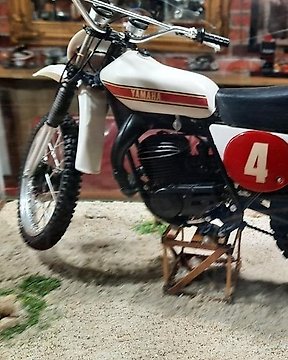
Tamiya - 1:6 - Yamaha YZ 250
Nr 80469477

Nr 80469477

WONDERFUL WORK OVERVIEW with photographs from 1925 and 1933 by Aenne Biermann (1998-1933).
Superb images that capture early modernity and the new way of seeing.
SUPER FRESH, LIKE NEW and UNREAD CONDITION.
Welcome to the "GERMAN PHOTOBOOKS" auction by Ecki Heuser (5Uhr30.com, Cologne) -
with more than 100 fantastic lots.
IF YOU WIN MORE THAN 1 OF MY BOOKS IN THIS AUCTION, YOU WILL PAY ONLY 1 X SHIPPING COSTS - WORLDWIDE.
Dirk Nishen, Essen. 1987. First edition, first printing.
Paperback with dustjacket. 215 x 280 mm. 142 pages. Photos: Aenne Biermann. Concept: Ute Eskildsen. Layout: Volker Heinze. Introduction: Ute Eskildsen. Text: Franz Roh, Walther Petry. Text in German.
Condition:
Inside and outside super fresh and flawless; marginal trace of use. Like new and unread. Overall near mint, near perfect condition.
Very beautiful German photo book in fantastic fresh condition by Aenne Biermann,
well known for Fototek 2 ("The literary dispute about photography").
"A self-taught photographer, Aenne Biermann was born Anna Sibilla Sternfeld into a wealthy mercantile family in Goch, on the Lower Rhine, where she received an education in culture and music. In 1920 she married Herbert Joseph Biermann, a prosperous textile merchant and art lover whose family was a founding member of the Jewish community in Goch; following their wedding, they moved to the progressive town of Gera. The couple soon had two children, Helga (born 1921) and Gershon (born 1923), who were the photographer’s first subjects.
An avid amateur mineralogist, it was through her collection of rocks that in 1926 she met the geologist Rudolf Hundt, who commissioned her to photograph his specimens the following year for his scientific work. Her photographs of minerals transformed her practice from the early personal views of her children to the close-up, direct studies of form that would define her photographs of plants and people that followed and make her a central figure in New Objectivity photography.
Thus 1926 began a period of intense productivity for Biermann that lasted until her untimely death, from liver disease, at the age of thirty-five, in 1933. In those years, Biermann published in international photography journals and participated in numerous exhibitions, including a solo show in 1929 at the Kunstkabinett, Munich, as well as the influential exhibitions Fotografie der Gegenwart in Essen and Film und Foto in Stuttgart, the same year. This exposure led to art historian Franz Roh’s choice to feature her work in the monograph 60 Fotos: Aenne Biermann (1930), the second (and, ultimately, final) volume in his Fototek series, securing her place in the photographic discourse of the era.
(Mitra Abbaspour, Associate Curator, Department of Photography, Museum of Modern Art, New York, 2014)
Jak kupować w serwisie Catawiki
1. Odkryj coś wyjątkowego
2. Złóż najwyższą ofertę
3. Dokonaj bezpiecznej płatności